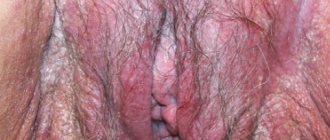Vaginal discharge is a normal physiological process that should not cause concern to a woman. They can appear at any age and represent a special secretion secreted by the genitals.
Odorless discharge performs extremely important functions - moisturize the mucous membranes, prevent pathogenic bacteria from entering the internal organs, and activate the process of self-cleaning of the vagina. But if a woman has white discharge with a sour odor, this may indicate various disorders in the female body.
What should normal discharge be like?
Normally, every girl of reproductive age has discharge before her period. The intensity of discharge may vary on different days of the month. For example, during ovulation or during sexual arousal, white, thick discharge often appears. As a rule, they do not cause discomfort and do not require medical intervention.
Normal vaginal discharge has the following features:
- They are colorless, with a slight whitish or yellowish tint.
- With a neutral, not pronounced odor.
- Do not cause discomfort, pain or burning.
- The volume of normal discharge from the intimate area should not exceed 4-5 ml.
- Consistency – liquid or creamy.
- With normal vaginal discharge, a woman does not need to wear sanitary pads.
Important! Any changes in the normal color or consistency of the discharge, a sour smell, cheesy discharge, itching, burning and any other uncharacteristic changes should alert the woman and be a reason for a visit to the doctor.
Treatment
Treatment of an unpleasant odor, accompanied by vaginal secretion of an uncharacteristic color, occurs only when the gynecologist has accurately established the cause of its appearance. Therefore, a girl should not rely on forums and start therapy on her own.
In the case of candidiasis, treatment involves the introduction and use of special products containing Clotrimazole, Fluconazole or Itraconazole in the composition. It is these substances that have an antifungal effect on pathogenic microorganisms. The attending physician prescribes a comprehensive treatment, which includes taking oral capsules, vaginal suppositories and probiotics. The latest drugs help restore the vaginal microflora.
If the odor was caused by inflammatory processes in the uterine area, a bacterial or viral infection, then treatment involves taking antibacterial, antiviral and immunostimulating agents. Long-term complex therapy and abstinence from sexual intercourse can restore the normal functionality of the woman’s reproductive system.
In advanced cases and with erosive-ulcerative disease, surgical intervention may be required. The doctor prescribes an additional examination of the patient’s entire body, after which he gives his permission for surgical treatment.
At home, you can independently prepare special baths from certain plants. Chamomile, calendula, fennel and lovage have antibacterial properties, so you can prepare a mixture of these herbs.
It is worth remembering that excessive washing can harm a woman’s microflora, causing an acid-base imbalance.
Reasons for such discharge
The sour smell of discharge in women can be associated both with physiological factors and with various diseases developing in the body. Most often, physiological causes are associated with hormonal disorders and are characterized by leucorrhoea with a sour odor.
As a rule, hormonal levels directly depend on the menstrual cycle. The first half of the menstrual cycle is characterized by the active production of estrogen, which is necessary for the full maturation of eggs. At the time of ovulation, as well as after fertilization of the egg, the discharge may become abundant and thick. This is due to the production of progesterone.
Note! Activity and regularity of sexual activity do not have any effect on hormonal levels - only the menstrual cycle.
Many women sometimes notice that their intimate secretions smell like sour milk. The reason for this phenomenon is considered to be the increased activity of special lactic acid bacteria, which are present in healthy vaginal microflora. Hormonal imbalances, prolonged use of antibiotics, and frequent stress lead to a regular increase in bacterial activity, resulting in an odor from the genital tract similar to sour milk.
The most common cause of foul-smelling vaginal mucus is considered to be poor personal hygiene. Irregular hygiene procedures and rare changes of underwear can lead to an unpleasant odor from the intimate area.
Causes and diagnosis
The causes of sour odor from the vagina are usually associated with a pathological process.
The predominance of pathogenic and opportunistic microorganisms disrupts the enzymatic and metabolic functions of the genitourinary system. During their active life, substances appear that provoke an unpleasant odor.
Among the main causes of the disease are:
- hormonal disorders;
- taking combined oral contraceptives;
- venereal diseases;
- chronic stress and overwork;
- decreased immunity, including during pregnancy;
- oncological neoplasms;
- non-infectious inflammatory diseases of the female reproductive system.
To confirm the diagnosis and identify the true cause of the sour smell, a comprehensive diagnosis is carried out. It involves general clinical examinations of blood, vaginal secretions, urine, and less commonly, feces.
To identify organic lesions, the following is carried out:
- ultrasound examination of the pelvic organs;
- magnetic resonance imaging;
- if necessary, diagnostic laparoscopy.
During the last procedure, it becomes possible to take a biopsy sample from the neoplasm to determine its structure and type.
Age characteristics
A sour vaginal odor can appear under various circumstances and at different periods of life.
Pathological discharge after infection with sexually transmitted diseases occurs depending on the incubation period of the introduced pathogenic bacteria. Typically, a woman notices the first symptoms after 1-2 weeks.
The development of thrush and bacterial vaginosis does not necessarily require contact with a sexual partner. Most often, these pathologies develop after severe stress and general overwork of the body. The smell, intensity and amount of leucorrhoea increases towards the middle of the cycle. When ovulation occurs, the hormonal background changes, so immediately after it, under the influence of other hormones, the bacteria are inhibited, the discharge is somewhat reduced, and its smell becomes less pronounced. Before menstruation in girls, pathological leucorrhoea can completely disappear.
During pregnancy, the nature of the discharge always changes: it acquires a brighter, more specific odor, becomes abundant, but remains mucous and does not indicate pathology. Blood and a brown tint may indicate a threat of miscarriage. In the early stages, for the unhindered attachment of the fertilized egg, the woman’s immunity weakens somewhat, so all chronic foci of infection tend to worsen. Often there is a pronounced sour smell due to candidiasis.
Antibacterial drugs must be taken strictly according to indications and after consulting a doctor. Antibiotics contribute to the death of not only pathogenic microorganisms, but also lactobacilli, which prevent infectious pathogens from settling in the vaginal cavity.
If bleeding occurs, consult a specialist.
For candidiasis, antifungal drugs are used (Fluconazole, Pimafucin). These medications can be prescribed in different forms:
- capsules;
- creams;
- vaginal suppositories;
- combinations of various dosage forms.
If the cause of acidic discharge from the genital tract is bacteria, antiseptic and antibacterial drugs are prescribed, most often used topically: in the form of suppositories and capsules. Douching with an aqueous solution of chlorhexidine or Miramistin is indicated. To eliminate itching and inflammation, use douching based on decoctions of nettle, linden or chamomile.
Treatment must be supplemented with probiotics - medicines containing normal microflora. They help restore immunity and replenish the necessary level of lactobacilli. This will take time and several courses of the drug.
Vaginal discharge (leucorrhoea) accompanies a woman every day, regularly followed by menstruation. By the appearance, color, consistency and smell of leucorrhoea, you can determine the woman’s health status and the day of her menstrual cycle.
Sometimes women notice a change in the smell and color of the discharge. The leucorrhoea becomes thick, white, similar to cottage cheese and smells like kefir. You should find out why your vaginal discharge smells sour. Is this normal or evidence of a disease?
The causative agents of this disease are yeast-like fungi from the genus Candida, representatives of which are often present in the vaginal microflora of a healthy woman.
For a long time, the causative agents of thrush do not manifest themselves in any way, however, with a decrease in immunity or under the influence of various factors, the fungi begin to multiply intensively, causing an inflammatory process in the vagina. This is manifested by the following, quite specific, symptoms:
- Curd-like thick vaginal discharge. They can be white, but when dry they change to yellow.
- Strong sour odor, comparable to the smell of kefir or sour milk.
- Itching in the vagina, perineum. In advanced cases or with severe damage, the itching can be unbearable.
- Burning in the vagina during and/or after sex, urination.
- Signs of perineal irritation: redness of the labia, appearance of rashes.
Discharge as a symptom of thrush
But discharge with the smell of sour milk can also be a symptom of various diseases, in most cases we are talking about thrush - a pathological change in the normal structure of the vaginal microflora. The causative agent of the disease is a fungus of the Candida group, which can be activated under the influence of the following factors:
- Long-term hormonal or antibiotic therapy.
- Decreased immune strength of the body.
- Tendency to frequent alcohol consumption.
- Regular douching.
- Frequent stress.
To identify thrush, you need to pay close attention to the nature of the secretion and the presence of additional signs. With candidiasis, a cheesy discharge with a sour odor may occur, which may systematically appear and disappear.
Thrush (candidiasis) – click to view
The main signs of thrush:
- Curd discharge with the smell of curdled milk.
- Itching, burning and discomfort in the intimate area.
- Sexual intercourse or urination is accompanied by pain and discomfort.
- The labia become swollen and swollen and may turn red.
Candidiasis requires mandatory consultation with a doctor, since if left untreated, the disease can spread to other, healthy internal organs. Complications of thrush can include bacterial vaginosis and various inflammatory processes in the pelvic area.
Diseases that affect the smell of discharge
The sour smell of discharge in women may indicate the penetration of pathogenic bacteria or viruses into the body that cause an inflammatory process.
Thrush
Most often, discharge with the smell of sour milk appears as a result of the vigorous activity of a yeast fungus from the genus Candida. It belongs to the opportunistic microflora and can live in the vagina for a long time without causing signs of disease. The following factors can provoke its reproduction: disturbances in the functioning of the immune system, the use of scented panty liners, the introduction of fungus from the carrier during sexual intercourse, wearing underwear made of synthetic materials, taking antibiotics, frequent douching, climate change, frequent changes of partners in intimate life.
In this case, the fungus begins to actively multiply, poisoning the body with its waste products and causing a disease such as thrush (candidiasis). It is accompanied by symptoms:
- Initially, a white, thick discharge resembling kefir.
- Severe itching in and outside the vagina.
- Hyperemia of the vulva.
- Subsequently, the discharge resembles cottage cheese with a strong sour milk smell.
- Quite severe discomfort during sex.
- Burning when passing urine.
- Pain above the pubis.
You can get rid of thrush with the help of antifungal agents, which are available in the form of tablets, capsules or suppositories. One of the most effective drugs for thrush is Fluconazole. A single dose of 150 mg can quickly relieve symptoms of the disease. But it is worth remembering that candidiasis in women of reproductive age is often combined with other infectious diseases, so its treatment should be comprehensive even after testing.
This is interesting: Are Hexicon suppositories used for thrush?
Ureaplasmosis
The causative agent of ureaplasmosis is tiny bacteria that parasitize the genitals, which are called ureaplasma. Infection occurs through sexual or household contact. These microorganisms can live in the body for a long time without revealing their presence.
The disease can be activated by: changes in hormonal levels (menopause, menstruation, taking contraceptives), active sex life and frequent changes of partners, diagnostic manipulations in the genitourinary system.
After the disease worsens, it manifests itself in the form of the following symptoms:
- A large amount of leucorrhoea, light or yellowish in color with a sour, not very pleasant odor.
- Burning in the urethra during urination.
- Aching pain in the abdominal area.
Ureaplasmosis is especially dangerous during pregnancy; it can lead to miscarriage, premature birth, and cause congenital pathologies in the fetus. Antibacterial therapy and immunostimulating drugs are used to treat the disease.
Gardnerellosis
Vaginal discharge with a sour odor may be due to bacterial vaginosis. This is a gynecological disease caused by a violation of the microflora. At the same time, the number of lactobacilli decreases, and other pathogenic microorganisms increase. Most often, their place is taken by gardnerella.
Factors that influence the development of the disease: taking hormonal drugs or antibiotics, frequent changes of partners in intimate life, violation of personal hygiene rules, frequent douching, medical procedures, abortions.
Against the background of bacterial vaginosis, inflammatory processes in the pelvic organs often occur. At the same time, Trichomonas, gonococci or candida are not detected in the secretions. The disease is characterized by the following symptoms:
- Copious discharge of white or gray color. Their volume increases after sex or before menstruation.
- Initially they are liquid, and if the disease is not treated within two years, they become viscous and sticky.
- The discharge may smell sour or smell like rotten fish.
In order to get rid of the disease, douching with Bifidumbacterin or Lactobacterin is used, as well as Vaginorm or Gynoflor suppositories.
Gonorrhea
Yellow discharge with a sour odor may appear in women with gonorrhea. Its causative agent is gonococcus bacteria. Gonorrhea is a sexually transmitted disease and is transmitted exclusively through vaginal or anal sex. The disease is not transmitted through household means.
Often the disease in women is asymptomatic, but in some cases, gonorrhea manifests itself in the form of the following symptoms:
- Leucorrhoea is yellow, white or green with a pronounced unpleasant sour odor.
- Pain in the urethra when passing urine.
- Frequent urge to urinate.
- Pain in the abdomen.
- Bleeding from the vagina between periods.
Gonorrhea in 30% of cases is combined with chlamydia, so it needs to be treated with drugs that can cope with both gonococci and chlamydia. You can get rid of the disease with the help of antibiotics (cephalosporins, penicillins). Most often, Cefix or Ciprofloxacin is prescribed in combination with Azithromycin or Doxycycline.
Chlamydia
Yellow discharge with a sour odor may indicate a disease such as chlamydia. It is caused by gram-negative bacteria - chlamydia. The disease is quite common and is sexually transmitted. Women are more susceptible to the disease than men.
Chlamydia manifests itself in the form of the following symptoms:
- Mucous leucorrhoea is yellowish in color with an admixture of pus and an unpleasant, in some cases sour, odor.
- Mild pain in the vagina.
- Itching of the vulva and urethra when urine passes.
- Abdominal pain that gets worse before menstruation.
- Bleeding.
- General weakness.
Antibiotics (tetracyclines, macrolides, fluoroquinolones) are used to treat the disease. Azithromycin makes it possible to quickly get rid of the disease. It is prescribed 500 mg once a day for 3 to 6 days.
Genital herpes
In some cases, the cause of leucorrhoea with a sour smell in girls is genital herpes. Its provocateur is the HSV2 virus. It is transmitted through sexual contact. The disease can be asymptomatic, and the person does not even realize that he is infected.
Factors that contribute to the activation of female diseases: infectious or chronic diseases that negatively affect the immune system, stress and depression, hypothermia, bad habits, hormonal changes.
In women, who are more likely than men to become infected with the disease, genital herpes manifests itself in the form of the following symptoms:
- In the initial stage, itching and burning also appear in the genital area.
- Lymph nodes enlarge.
- Painful blisters filled with liquid appear on the surface of the skin and mucous membrane, and they are marked with redness.
- Sour, unpleasant-smelling leucorrhoea may occur.
- After a few days, the blisters open, and in their place ulcers and erosions form.
This is interesting: Which device for measuring blood pressure is better: how to choose a tonometer for home use
Once the released herpes virus has entered the body, it remains there forever. But over time, the number of relapses of the disease decreases.
It will not be possible to completely get rid of herpes, but it is possible to reduce its symptoms, for which the antiviral agents Cycloferon, Gerpevir, and Acyclovir are used. Particular attention should be paid to restoring immunity. This makes it possible to minimize the number of exacerbations.
Bacterial
Bacterial vaginosis is a disease that occurs due to a violation of the alkaline microflora of the genital organs and a decrease in the number of lactobacilli. Most often, the reasons for the development of bacterial vaginosis are long-term use of antibiotics, disturbances in the hormonal balance of the female body, and deterioration of the immune system. The disease can be provoked by too frequent douching, which washes out beneficial lactobacilli from the vagina, pathologies of the digestive system, and promiscuous sex life.
Attention! Yellow discharge in women, as well as thick brown mucus, most often accompanies bacterial vaginosis, which is caused by a pathogenic bacterium from the genus Gardnerella vaginalis.
The disease in most cases occurs during pregnancy, which is associated with serious hormonal changes in the body of the expectant mother. A sign of bacterial vaginosis is a mucous fluid of a gray or white hue with a sharp, unpleasant fishy odor. In advanced stages, yellowish or green discharge may appear.
With bacterial vaginosis, there is a high risk of rupture of the membranes and, as a result, premature birth. Therefore, such women are under constant medical supervision throughout the entire period of pregnancy.
In pregnant women
Literally from the first days of pregnancy, a woman’s hormonal background changes significantly. In order to preserve the fetus in the first trimester, the body produces large amounts of progesterone. In this case, the woman experiences a white, thick discharge that is odorless or has a faint sour odor.
The smell of discharge during pregnancy often becomes different, since the immune system does not work at full strength during this period, which allows microorganisms inhabiting the vagina to multiply more actively. This applies not only to beneficial bacteria, but also to opportunistic flora.
White discharge with a sour odor during pregnancy may indicate that a woman has worsened thrush, which is a fairly common companion during this period. It is characterized by an increase in the amount of leucorrhoea. They resemble cottage cheese and are accompanied by itching and burning in the genital area.
To treat thrush during pregnancy, in most cases, Pimfucin suppositories are used. The active ingredient of this drug does not penetrate the mucous membranes, therefore it does not have a systemic effect and cannot harm the fetus.
Also, a pregnant woman is often worried about other chronic diseases, such as chlamydia or genital herpes. Their symptoms are no different from those observed at other times. Manifestations of these diseases also include the occurrence of acidic discharge.
Since most medications are contraindicated during pregnancy, it is dangerous to prescribe treatment yourself.
If the smell of the discharge has changed, a different shade has appeared, or an unpleasant sensation has appeared, you should immediately consult a gynecologist and act according to his recommendations.
Sexual infections
Acid discharge in women often occurs due to promiscuity or unprotected sexual intercourse. The cause of the problem is the penetration of infection into the genitourinary tract - this could be chlamydia, trichomoniasis or gonorrhea. You can determine the exact type of infection by passing all the necessary tests, as well as paying attention to other symptoms of the disease.
With trichomoniasis, a woman notices heavy discharge before menstruation, which is characterized by a yellow, green or brown tint. Signs of the disease also include pain, burning and discomfort during urination and sexual intercourse. Painful, bleeding wounds and erosions may appear in the intimate area.
Prevention measures
There are many preventive measures that help a girl maintain the health of her entire reproductive system.
The main preventive measures include:
- Regular washing and maintaining personal hygiene. To do this, you need to purchase a suitable intimate hygiene product that does not cause irritation and does not inhibit beneficial microflora.
- Give choice in favor of underwear made of natural fabric that fits loosely to the body. Synthetics irritate the delicate skin of the genitals, and tight underwear disrupts the normal blood flow to the organs. Therefore, a girl should choose underwear in which she can feel comfortable.
- Treat colds, bacterial and viral diseases in a timely manner. Timely treatment will avoid antimicrobial therapy. Antibiotics cause an imbalance of microflora, which causes creamy discharge.
- Change your underwear and panty liners regularly. This will not allow pathogenic microorganisms to multiply in an environment that is comfortable for them.
- Several times a year, undergo a medical examination by a gynecologist and take all the necessary tests. This will allow you to monitor your health and identify the pathological process in a timely manner.
If the unpleasant odor is caused by stress, then you need to get rid of the irritants and take a course of sedatives.
Treatment methods
To treat discharge and sour odor in women, it is necessary to conduct a full examination of the body to determine the cause of the pathology. Treatment is prescribed only by a gynecologist who will study the symptoms of the disease.
Heavy discharge that occurs due to physiological factors does not require any special treatment. In case of severe hormonal imbalance in the female body, various hormonal drugs can be used to compensate for the deficiency of the necessary substance. All hormonal medications are prescribed only by a doctor. Under no circumstances should you change the dosage and duration of treatment on your own.
White thick discharge resulting from thrush is treated with special antimycotic drugs. Such medications are available in various pharmacological forms - tablets, vaginal suppositories. To eliminate unpleasant, painful symptoms, itching or burning, creams and ointments for external use may be additionally prescribed. The most commonly used are Terzhinan, Pimafucin, and Flucostat.
On a note! If it is determined that discharge before menstruation is associated with thrush, it is necessary to treat not only the woman, but also her sexual partner. During the entire course of treatment, sexual contact should be avoided.
Discharges accompanying the development of bacterial vaginosis are recommended to be treated with broad-spectrum antibiotics. As a rule, antibiotic therapy is considered one of the most effective - the first positive results of treatment can be noticed within a few days after taking antibiotics. The drug is selected individually depending on the main causative agent of the disease.
The treatment process can be supplemented with special multivitamin complexes, immunomodulators - drugs to increase the body's immune forces, as well as special medications intended to normalize the vaginal microflora. These include Linex, Bifiform.
When diagnosing a fungal or any other infection in pregnant women, the use of medications for internal use is strictly not recommended. The most preferred are ointments, creams and lotions for external use, which do not affect the development of the fetus.
Expectant mothers can use various traditional medicine recipes - decoctions, douching. Medicinal plants are used for preparation.
Important! Medicinal plants have a number of contraindications, some of which are not allowed during pregnancy. Before using any herbal medicine recipes, you should definitely consult a gynecologist.
If your discharge smells sour during pregnancy
Uncharacteristic vaginal secretions cause great concern in a pregnant woman, as this may mean that the baby is in danger. Doctors rush to reassure expectant mothers and assure that this is a normal natural process that indicates hormonal changes in the body.
A pregnant woman's body becomes more vulnerable to pathogenic microorganisms, since during gestation the immune system decreases, hormonal levels and the structural arrangement of many organs change. Therefore, the expectant mother should devote more time to personal hygiene, medical examinations and her health.
Attention should be paid to vaginal secretions only when it begins to take on an unhealthy color or becomes of a different consistency.
If the vaginal secretion becomes cheesy or creamy in consistency with the smell of kefir, fish or purulent substances, you should contact your gynecologist. Such symptoms indicate the onset of pathogenesis in the pregnant woman’s body, which can lead to negative consequences, including miscarriage.
In case of bleeding, which is accompanied by sharp pain and an unpleasant odor from the vagina, it is better for a woman to immediately consult a gynecologist. During pregnancy, such symptoms indicate an ectopic pregnancy or fetal death. In the first case, the doctor performs abdominal surgery on the uterus to sew up the fallopian tubes and clean out the entire cavity. If the fetus freezes in the later stages, the obstetrician-gynecologist decides to carry out childbirth under the influence of stimulant drugs.
Basic rules of prevention
To prevent the appearance of vaginal discharge with an unpleasant sour odor, every woman should know the basic rules of prevention.
Remember! Many women try to get rid of the unpleasant odor in the intimate organs and “mask” it with the help of various perfumes or cosmetics. This is not recommended under any circumstances; it is necessary to treat the cause of the disease.
- Be extremely careful about personal hygiene, wash your genitals at least twice a day.
- For hygiene procedures, it is best to use not ordinary soap, but special pharmaceutical products - they not only remove dirt, but also restore the normal microflora of the vagina.
- If a woman notices that after drinking alcoholic beverages, hot, spicy or pickled foods, redness, itching or burning occurs in the perineal area, she should stop consuming them.
- Wear underwear that is not too tight, made from natural, breathable materials.
- When bathing, every woman should remember that the genitals should be washed towards the anus - otherwise there is an extremely high risk of transferring pathogens from it to the vaginal cavity.
Representatives of the fair sex are not recommended to constantly wear tight clothing, in particular trousers. This blocks free access of air to the genitals, which is an excellent environment for the increased activity of various pathogenic microorganisms.
White discharge without a distinct odor is a normal physiological phenomenon that is normally present in every woman. But any changes in the hue, smell or consistency of the discharge should alert you, because they may indicate the development of serious diseases. Under no circumstances should you put off visiting a doctor. Treatment started in the early stages of the disease always brings the most effective results.
The smell of female discharge, classification
Leucorrhoea has not only a different color, but also a different smell, and accordingly, the reasons for its occurrence will be different. They are classified in the following order:
Fishy smell
A possible cause is dysbacteriosis of the vaginal microflora; accompanied by discomfort and severe itching; if left untreated, it leads to inflammation of the internal organs of the reproductive system.
Smell of garlic or onion
The aroma of garlic or onions suggests a malnutrition or weakened immune system. It is much more serious if the cause is a fungal disease.
The smell of rotten meat
If it smells like rotten meat, then gardnerella may have entered your body. Leucorrhoea in this case has a grayish color. At first, bacteria settle on the mucous membrane of the vaginal walls, then, if left untreated, they affect the genitourinary system, which can lead to serious consequences.
Urine smell
Unpleasant urine odor can be a consequence of stress. Extra pounds can also cause such discharge. The pressure of the weight in the peritoneum causes a small amount of urine to enter.
Sour smell
A sour vaginal odor often accompanies thrush. Caused by candida fungi, it can lead to the development of vulvovaginitis. Additional symptoms: itching, redness, burning, cheesy discharge.
Acetone smell
An acetone aroma is a clear sign of diabetes. The body naturally removes accumulated ketone bodies. They mix with body fluids, including vaginal secretions.
The smell of iron
The smell of iron comes from blood mixed with secretions. This is what the vagina smells like during menstruation, but it can also signal erosion of the cervix.
It is worth immediately determining what secret the vagina secretes so that you can understand its origin. Treatment should only be carried out by a doctor.
How to treat?
If there is a suspicion that the secretion has changed under the influence of an infection or due to any disease, you should first consult a gynecologist. Before starting treatment, a full diagnosis is required to help determine the exact cause of the changes. Usually a smear is taken and the microflora is examined. An analysis of symptoms alone is usually not enough; an ultrasound of the reproductive system may also be required.
After identifying infection and other diseases, full treatment is carried out. This may include the use of various medications. Local remedies can be used, such as creams and suppositories that help restore normal microflora, or oral tablets. You may also need to restore your immune system, take vitamins and other strengthening agents. You should usually abstain from intimacy during treatment.
If changes in the nature of discharge were caused by hormonal drugs and other medications, you should consult your doctor. Perhaps the drug can be changed to eliminate such side effects.
https://youtu.be/9oOqtzkq2wk
When should you see a doctor if you have white discharge?
If a girl or woman has no more than a teaspoon of white discharge per day and is not accompanied by other unpleasant symptoms, then there is no need to worry. However, if the discharge becomes very copious, cheesy, foamy, thick, brown discharge appears in the middle of the cycle. the color changes to yellow, green, gray, any unpleasant odor appears, especially if any of the above is accompanied by itching, burning, pain, or even low-grade, low-grade fever - this is a reason to consult a doctor:
- First, the gynecologist performs an examination on the chair. In the mirrors you can see the walls of the vagina and the cervix - what condition they are in, whether they are inflamed or not, whether there are pathological discharges from the cervix and what they are.
- In some cases, the doctor may perform a colposcopy to exclude or confirm cervical dysplasia or erosion.
- If an STI is suspected, in addition to the usual smear for flora and culture, the gynecologist may refer you for a smear test using the PCR method.
- If the patient complains of pain, menstrual irregularities, etc., if inflammatory diseases of the uterine appendages or the uterus itself are suspected, a transvaginal ultrasound is indicated, which can help in establishing the full clinical picture.
Types of Abnormal Vaginal Odors
An unpleasant odor from the vagina can most often indicate the presence of an infection: pathogenic microbes tend to emit specific gases that are sources of an unpleasant odor.
In infectious diseases, it can be different: putrid, sour, pronounced and weak, often accompanied by itching and burning of the external genitalia. However, sometimes it is the odors of an intimate place that can clearly indicate a problem that is worth seeing a doctor, and every woman should know about this. Therefore, if you have a smelly vagina, it is better not to use home remedies, and the best way to get rid of the bad smell is to make an appointment with a gynecologist!
✘ Note to men! One thing you should never do is tell your girlfriend that her vagina stinks. Women are quite sensitive to their private parts, and if you happen to be so close to your partner's genitals that you can feel their strong smell or nasty taste, then be creative and report your unpleasant discovery in the most delicate manner possible!
What should you do if a woman’s vaginal discharge smells unpleasant – like rotten fish, herring with onions and garlic, then mixed with sour milk and other gastronomy? Moreover, the unpleasant odor in an intimate place is strong and can be felt even from a distance? The correct approach to this situation and avoiding self-medication at home will help you get rid of the problem! By following the wrong advice and opinions from reviews on forums, you can waste valuable time, develop an illness, and develop complications.
⚠ Remember that you need to fight not the smell, but the cause of its appearance: a disease (inflammatory or infectious process) or an imbalance of microflora.
Before you start, you first need to find out the cause of this scourge. It is not an independent disease, it is only a symptom that is caused by a more serious pathology that requires treatment. And since in 90% of cases the unpleasant smell of the vagina is caused by discharge, you should start by diagnosing the cause - checking with a gynecologist in the chair and taking tests for infections.
Have a problem and think where is the best place to go with this issue in Moscow? Having established the source of the unpleasant odor, the doctor at our “Gynecology Clinic” will be able to prescribe a treatment that is effective in your particular case - the use of antibacterial drugs, aerosols, gels, creams and suppositories will help to effectively and quickly remove strong odor from your intimate area! We accept daily from 10-00, including Saturdays and Sundays.
• Smear for the degree of purity;• Smears for microflora;• Analysis of bacterial culture of secretions with determination of antibiotic sensitivity;• PCR diagnosis of “latent infections”;• Analysis of florocenosis;• Analysis of bacterial vaginosis;• Gram microscopy;• NASBA complex.
3 simple steps to success or how to rid your vagina of unpleasant odor:
- Realize that the way your vagina smells now is not the norm,
- Urgently make an appointment with a gynecologist in a good clinic,
- Get a chairside examination and be tested for STDs.
There are two “flavors”, after which one can judge the presence of infection:
- Acidic vaginal discharge. They often indicate a disease such as thrush. This disease occurs when the acidity of the microflora changes. In addition to being sour, they are white in color. The consistency is reminiscent of curd sour cream. A burning sensation may be felt in the labia area.
- Discharge with a rotten odor. The “aroma” of missing fish indicates the presence of a disease such as bacterial vaginosis. Even people around you can hear this stench. The disease is dangerous, because lack of treatment can lead to serious consequences.
For pathologies and diseases
Brown, green, yellow and white discharge with a sour odor can be disturbing due to gynecological disorders, inflammatory processes and infectious diseases.
Candidiasis
Thrush is considered a common problem among women. In most cases, this is what causes white discharge with a sour odor.
Symptoms are characterized by the appearance of a creamy or curdled secretion that smells like sour milk, kefir or yogurt. Along with curd underwear, unbearable vaginal itching and burning may occur. The odor released is caused by fungi of the Candida family, hence the name of the disease - Candidiasis.
It can be transmitted either sexually or occur as a result of disruption of the natural vaginal microflora due to a weakened body, physical activity, lactobacilli deficiency, or taking antibiotics. Therefore, such cervical fluid can be observed in girls who are not sexually active.
The most pronounced symptoms of thrush are during menstruation, after or before their onset.
Eliminating thrush is not difficult, but in 40% of situations, the curd secretion with a cheesy smell can return with the slightest weakening of the immune system or metabolic disorder. This is due to the characteristics of the body and the composition of the microflora.
Inflammation
If the discharge smells of a sour, cheese, kefir aroma, its color changes to yellow and it looks like a jelly-like thick substance, then this is an inflammation of the internal organs of the reproductive system. Perhaps it affected the ovaries - adnexitis, or the fallopian tubes - salpingitis. In this case, pain is felt in the left lower abdomen, and during a bilateral process, the entire peritoneum aches.
Bacteria and infections
If the vaginal secretion is excessively thick, accompanied by burning, itching, pain during urination and sexual intercourse, then you should be wary of infectious gonococcus or streptococcus. These diseases over time give the mucus a purulent characteristic, reminiscent of milk.
The sour smell of greenish discharge with a sticky consistency indicates a purulent process, which is most often caused by infectious diseases or advanced inflammation.
Erosion
Dark brown discharge may be observed due to the presence of cervical erosion. Symptoms include periodic pain in the lower abdomen, however, this pathology often occurs in a latent form. Therefore, at the first suspicion of this, it is important to immediately visit a gynecologist. If there is blood, women's discharge may smell like iron.
Norm
Leucorrhoea consists of mucus secreted by special glands, epithelial cells and representatives of the vaginal microflora (about 12 species).
The vaginal microflora is formed a day after birth. The main composition of the flora at this moment is lactic acid bacteria received from the mother during childbirth. Gradually, the settlement of other representatives of micro life occurs:
- Staphylococci.
- Streptococci.
- Enterococci.
- Bacteroides.
- Corynobacteria.
- Bifidobacteria.
- Lactobacilli and others.
The microflora of a healthy woman of European origin contains several types of lactobacilli or Doderlein bacilli. It is the presence of this type of organism in the vagina that can affect the smell of the discharge. It is usually neutral or sour.
The following discharge is considered normal:
- Whitish, creamy consistency.
- Dense lumps, whitish or slightly yellow.
- Stretching transparent discharge, reminiscent of egg white.
- Viscous, easily extensible discharge, white or yellow in color.
- Cloudy, whitish.
The moment of white discharge should be painless and practically unnoticeable. There should also be no itching, burning, pain or other unpleasant symptoms. The smell, as mentioned above, is absent or slightly sour.
Vaginal discharge is necessary for the body for several purposes:
- Lubrication necessary during sexual intercourse to reduce friction of the genitals and prevent injury.
- Keeps the vaginal mucous membranes from drying out.
- Protects reproductive organs from infections.
- Cleanses the genitals of dead cells and pathogenic microorganisms.
Under the influence of various factors, the composition of the vaginal microflora may change, and, accordingly, the color, consistency and smell:
- Phases of the menstrual cycle.
- Hormonal levels that change due to pregnancy, day of cycle, illness.
- Use of contraceptives, including lubricants, condoms, and oral contraceptives.
- Maintain personal hygiene.
- Degree of sexual activity, sexual preferences, frequent change of sexual partners.
- Age criteria.
- State of immunity.
- The presence of infectious and inflammatory diseases.
Physiological reasons
As mentioned above, the work of the female reproductive system is very complex and depends on many factors, and therefore smell is not always a sign of the development of pathological conditions. Normally, vaginal secretion must meet the following requirements:
- Be watery or have a slimy consistency.
- Excreted in an amount of no more than 4–6 ml per day (in the absence of pathological processes, they are practically invisible and do not require the use of panty liners).
- Be transparent or white (in the latter case they are simply called leucorrhoea).
- To be odorless or to give off a sour aroma.
- Do not provoke irritation in the perineum.
If there is no stinky odor, but the shade has changed to yellow, this may be due to some physiological reasons:
- Ovulation or menstruation. A small amount of leucorrhoea in the first week of the cycle is normal. But after the egg is released, the mucus may turn light yellow. Shortly before your period, blood is mixed with the secretion, so it turns brown. You need to monitor your menstrual cycle.
- Change of partner. In sexual relations with a man, the microflora of the female vagina becomes accustomed to a certain set of microorganisms. When changing partners, a woman's reproductive system must adapt to the new environment. This can cause yellowing of the leucorrhoea and an increase in the amount of discharge.
- Allergic reaction. It can be caused by using tampons or pads, or wearing synthetics. As a result of an allergic reaction, the mucous membrane becomes inflamed, the discharge changes color, and itching occurs.
- Lactation period. When changes occur in hormonal levels, leucorrhoea can change in thickness and color. After a woman stops breastfeeding, everything returns to normal.
- Pregnancy. Increased blood circulation causes an increase in the amount of discharge. And shortly before childbirth, the leucorrhoea becomes yellow and thickens.
- Menopause. During this period, due to hormonal changes, the amount of leucorrhoea decreases, but it may acquire a yellow tint.
When is white discharge considered normal?
Often, white discharge in girls is somewhat more abundant than in women of reproductive age, middle age, or women during menopause. This is explained by the fact that in girls the hormonal levels are just forming and beginning to stabilize, while in middle-aged women this process is already completed and is more permanent. Normally, both in girls and in women before menopause, the vagina has a slightly acidic environment due to the presence of lactobacilli, which form lactic acid. This environment is destructive for pathogenic microorganisms; it is unfavorable for the proliferation of pathogenic bacteria. So, what kind of discharge can be considered normal?
- The color of the discharge should not be particularly noticeable; most often it is transparent, but a slightly creamy, white or slightly yellowish tint may appear.
- Normal discharge should be odorless
- The consistency should be watery, liquid, not thick; in the middle of the cycle during ovulation there may be transparent, stretchy mucous discharge
- The norm of discharge per day should not be more than a teaspoon
- The amount of discharge may increase before menstruation, during sexual arousal and after sexual intercourse.
Natural causes of sour-smelling discharge in women
Not all such discharge in women has a pathological basis. Let us list the reasons for physiological changes:
- During the menstrual cycle, the level of hormones: estrogen and progesterone, constantly varies. During ovulation, before or after menstruation, a thick and more abundant yellowish mucous secretion is secreted. It can acquire such a scent. It is also known that at such moments, women’s discharge tastes sour and sour.
- During premenopause or mid-menopause, the sour smell of discharge without itching in women is explained by hormonal changes.
- The cause of this symptom is often the use of medications or contraceptives.
- An allergic reaction to synthetic underwear or improperly selected intimate hygiene products can trigger various fragrances.
- Acidic cervical fluid in adolescents is also explained by the excessive effect of hormones and the final formation of the reproductive system. That is why even a girl who is not sexually active can experience this symptom.
- Lack of proper hygiene provokes various aromas in the genital area, sometimes it can even smell strongly of sour cabbage, rotten cheese, and vinegar.
- Metabolic disorders, weakened immunity, stress, colds, use of antibiotics and even poor nutrition can disrupt the natural microflora of the vagina and the balance of lactic acid bacteria, which contributes to the predominance of pathogenic microorganisms. This process may be a prerequisite for the release of a creamy secretion with the described aroma.
- Frequent douching often leads to disruption of the water balance of the mucous membrane, which is why the glands urgently begin to produce a liquid transparent secretion with a similar aroma.











